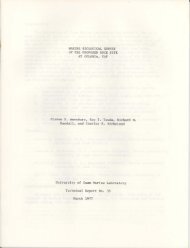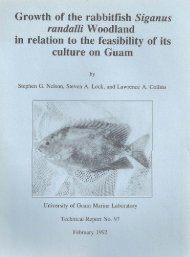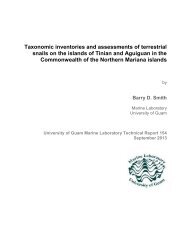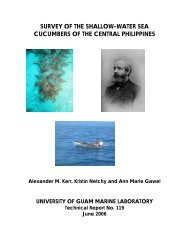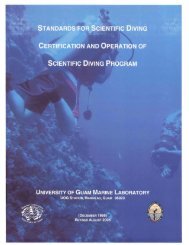Marine Protected Area Surveys Central Visayas, Philippines 2007
Marine Protected Area Surveys Central Visayas, Philippines 2007
Marine Protected Area Surveys Central Visayas, Philippines 2007
Create successful ePaper yourself
Turn your PDF publications into a flip-book with our unique Google optimized e-Paper software.
Raymundo and Maypa 2008 UOG Tech. Rep. 122<br />
from 2006 (70.3% in the MPA; 66.2%<br />
in the fishing ground). There was<br />
some rubble and dead coral in both<br />
areas of the reef, most of it occurring<br />
in extensive branching Montipora<br />
beds. A total of seven sea turtles<br />
were observed during fish visual<br />
census, and one of the patches of<br />
coral breakage was speculated to be a<br />
turtle bed. Another potential source of<br />
rubble and dead coral was a COTS<br />
outbreak which occurred 3-5 years Figure 13. High relief and coral cover along the reef<br />
crest in the Basdiot MPA. Note the abundance of<br />
ago, according to anecdotal reports.<br />
fragile branching growth forms.<br />
However, the increase in live hard<br />
coral cover suggests that recovery from these sources of mortality is rapid and high. Fish<br />
assemblage diversity was significantly higher within the MPA than in the fishing ground (Fig. 6),<br />
which probably reflects the effects of management and recovery.<br />
Mean total disease prevalence averaged 4.1% within the MPA and 8.4% in the fishing<br />
ground; both values are higher than those calculated for 2006 (2.5% in the MPA; 6% in the<br />
fishing ground). White syndrome and skeletal eroding band were the most common diseases,<br />
and ulcerative white spots, black band disease, growth anomalies were also present. Drupella<br />
were common, particularly since Montipora is a preferred food source, though they were much<br />
more dense within the fishing ground than within the MPA.<br />
Saavedra<br />
This reef has been recently affected by a COTS outbreak; an anecdotal report from the<br />
Coastal Conservation Education Foundation stated that there had been a removal activity 3<br />
weeks prior to our surveys. The reef crest showed high complexity, and table growth forms of<br />
the genus Acropora and massive Porites were common (Fig. 14). The reef flat was dominated<br />
by pavement and patch reefs. Live hard coral cover within the MPA had decreased from 2006<br />
(75.9%) to 65.7%, which may possibly reflect high coral mortality from COTS and Drupella. Live<br />
coral cover in the fishing ground was similar to that in the previous year (2006: 62.9%; <strong>2007</strong>:<br />
60.2%). We observed several large colonies of table Acropora and thickets of staghorn<br />
17





